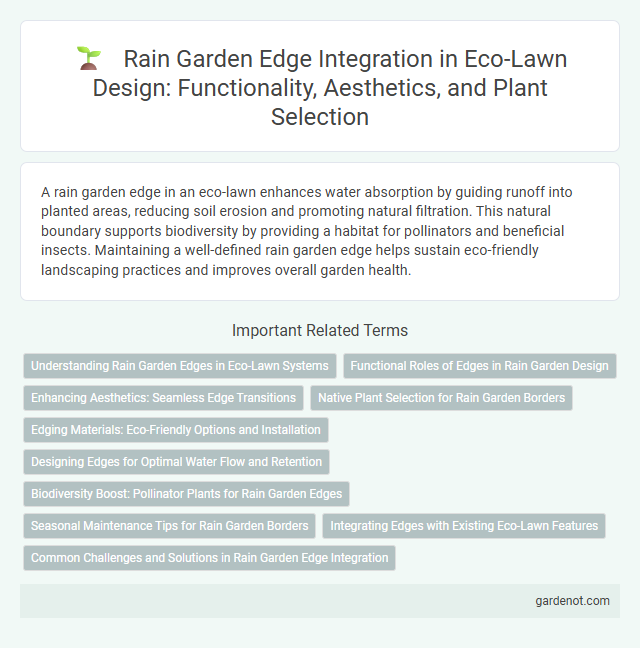A rain garden edge in an eco-lawn enhances water absorption by guiding runoff into planted areas, reducing soil erosion and promoting natural filtration. This natural boundary supports biodiversity by providing a habitat for pollinators and beneficial insects. Maintaining a well-defined rain garden edge helps sustain eco-friendly landscaping practices and improves overall garden health.
Understanding Rain Garden Edges in Eco-Lawn Systems
Rain garden edges in eco-lawn systems are crucial for managing stormwater runoff and enhancing water infiltration. These edges act as natural buffers that prevent soil erosion while promoting the growth of native plants suited for moist conditions. Properly designed rain garden edges improve biodiversity and contribute to sustainable landscape practices by integrating seamlessly with eco-lawn vegetation.
Functional Roles of Edges in Rain Garden Design
Rain garden edges serve crucial functions by enhancing water retention and directing runoff into the garden, promoting efficient stormwater management. The design of edges supports soil stabilization, preventing erosion while creating distinct microhabitats for native plants and beneficial insects. Integrating porous materials and varying edge heights improves infiltration rates, making rain garden edges vital for sustainable eco-lawn systems.
Enhancing Aesthetics: Seamless Edge Transitions
Rain garden edges with seamless transitions enhance aesthetics by creating a natural flow between the lawn and planted areas, minimizing harsh lines and promoting visual harmony. Integrating eco-lawn grasses with native perennials along these edges fosters biodiversity while maintaining a lush, green appearance. Precise edging techniques reduce soil erosion and water runoff, contributing to the garden's overall ecological health and curb appeal.
Native Plant Selection for Rain Garden Borders
Selecting native plants for rain garden edges enhances water absorption and supports local biodiversity by attracting pollinators such as bees and butterflies. Species like Switchgrass (Panicum virgatum), Blue Flag Iris (Iris versicolor), and Cardinal Flower (Lobelia cardinalis) thrive in wet conditions and stabilize soil to prevent erosion. Incorporating these native plants ensures a resilient, low-maintenance rain garden border that effectively manages stormwater runoff.
Edging Materials: Eco-Friendly Options and Installation
Rain garden edges benefit from eco-friendly edging materials such as natural stone, recycled rubber, and untreated wood, which enhance sustainability and aesthetics. Proper installation involves securely anchoring edges to prevent soil erosion while allowing adequate water infiltration and plant growth. Selecting permeable materials supports water management and contributes to the ecological function of eco-lawns and rain gardens.
Designing Edges for Optimal Water Flow and Retention
Rain garden edges should be carefully designed to channel water efficiently while preventing overflow and erosion. Incorporating gentle slopes and berms composed of native plants enhances water retention and promotes infiltration. Strategic placement of porous materials along the edges further improves drainage, supporting sustainable water management in eco-lawn landscapes.
Biodiversity Boost: Pollinator Plants for Rain Garden Edges
Rain garden edges planted with diverse pollinator-friendly species significantly enhance local biodiversity by attracting bees, butterflies, and other beneficial insects essential for ecosystem health. Incorporating native flowering plants such as milkweed, coneflowers, and bee balm not only supports pollinator populations but also improves soil quality and water filtration in eco-lawn environments. Strategic selection of these pollinator plants contributes to sustaining urban wildlife corridors and promotes resilient, self-sustaining rain garden ecosystems.
Seasonal Maintenance Tips for Rain Garden Borders
Rain garden edges require seasonal maintenance to ensure optimal plant health and water absorption. In spring, remove debris and prune dead foliage to promote growth, while summer calls for weeding and watering during dry spells to prevent plant stress. Fall involves cutting back perennials and adding mulch to protect roots and control erosion during winter months.
Integrating Edges with Existing Eco-Lawn Features
Integrating a rain garden edge with existing eco-lawn features enhances water absorption and supports biodiversity by creating a seamless transition between permeable turf and native plant zones. Strategically placing deep-rooted, drought-tolerant plants along the edge captures runoff while maintaining the eco-lawn's low-maintenance, sustainable characteristics. This edge integration promotes soil health, reduces erosion, and improves habitat connectivity for pollinators and beneficial insects.
Common Challenges and Solutions in Rain Garden Edge Integration
Rain garden edge integration often faces challenges such as soil erosion, poor water infiltration, and plant selection compatibility. Addressing these issues requires stabilizing the edge with native deep-rooted plants and using permeable materials to enhance drainage and prevent runoff. Proper grading and regular maintenance ensure the rain garden edge functions effectively, promoting a sustainable ecosystem within the eco-lawn.
Rain garden edge Infographic

 gardenot.com
gardenot.com